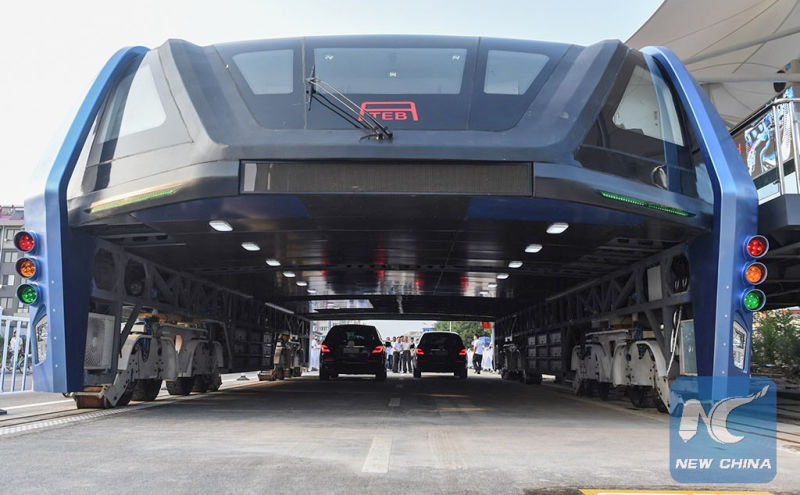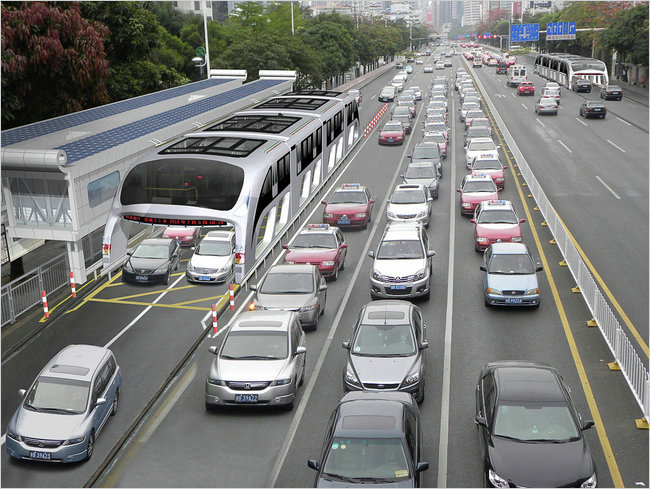Transit Elevated Bus (TEB)
Contents |
[edit] Concept
In August 2016, a futuristic public transport solution, the Transit Elevated Bus (TEB), began being tested in Qinhuangdao, China.
Chinese company Shenzhen Huashi Future Parking Equipment proposed the innovative design as a way of addressing the problem of congestion caused by rapid urbanisation and population growth of many of China's cities.
The TEB is a bus that straddles traffic by driving over the top of it, running along fixed tracks. Its main compartment is elevated, leaving the street clear for cars underneath. The design also incorporates solar panels on the roof and at bus stops to partially power the vehicle.
The vehicles could be capable of holding up to 1,200 passengers each and travel at 40 m/h (60 km/h). Designers estimate that the vehicles could reduce traffic congestion on main roads by 25-30%. They also highlight the relative affordability of the system - the construction cost of one TEB and 25 miles of route facilities is estimated at around $7.4 m, one-tenth the cost of building the same length of subway line.
Youzhou Song, the vehicle’s designer said: “The straddling bus could replace up to 40 conventional buses, potentially saving the 860 tons of fuel that 40 buses would consume annually, and preventing 2,640 tons of carbon emissions.”
[edit] Prototype
When the designs were first proposed many around the world greeted them with scepticism, however, testing on a prototype began in August 2016. The bus measures 22 m in length x 7.8 m wide (72 ft x 25 ft),
The testing is taking place on 300 metre-long test track, evaluating the braking system, drag and power consumption. Once complete, it will progress on to further testing stages.
But the TEB isn’t ready to deal with competing traffic just yet. For now, the TEB is limited to a 300 meter long test track that will evaluate the braking system, drag and power consumption. Once complete, the straddling bus will move on to further testing stages.
Despite being an unproven solution, countries such as Brazil, France and India have expressed their interest in introducing TEBs of their own.
[edit] Updates
In June 2017, the Chinese press reported that the idea of TEB as a mass-transport system had been abandoned.
Having had a prototype developed, reports suggest that those who tested it were left underwhelmed, with some saying that it ran too slowly and became overheated.
Other issues that have been cited for the scrapping of the elevated bus include the way it interacts with other vehicles, particularly those fitted with roof-racks, and other features of the city environment, such as low bridges.
[edit] Find out more
[edit] Related articles on Designing Buildings Wiki
Featured articles and news
The UK's Modern Industrial Strategy: A 10 year plan
Previous consultation criticism, current key elements and general support with some persisting reservations.
Building Safety Regulator reforms
New roles, new staff and a new fast track service pave the way for a single construction regulator.
Architectural Technologist CPDs and Communications
CIAT CPD… and how you can do it!
Cooling centres and cool spaces
Managing extreme heat in cities by directing the public to places for heat stress relief and water sources.
Winter gardens: A brief history and warm variations
Extending the season with glass in different forms and terms.
Restoring Great Yarmouth's Winter Gardens
Transforming one of the least sustainable constructions imaginable.
Construction Skills Mission Board launch sector drive
Newly formed government and industry collaboration set strategy for recruiting an additional 100,000 construction workers a year.
New Architects Code comes into effect in September 2025
ARB Architects Code of Conduct and Practice available with ongoing consultation regarding guidance.
Welsh Skills Body (Medr) launches ambitious plan
The new skills body brings together funding and regulation of tertiary education and research for the devolved nation.
Paul Gandy FCIOB announced as next CIOB President
Former Tilbury Douglas CEO takes helm.
UK Infrastructure: A 10 Year Strategy. In brief with reactions
With the National Infrastructure and Service Transformation Authority (NISTA).
Ebenezer Howard: inventor of the garden city. Book review.
The Grenfell Tower fire, eight years on
A time to pause and reflect as Dubai tower block fire reported just before anniversary.
Airtightness Topic Guide BSRIA TG 27/2025
Explaining the basics of airtightness, what it is, why it's important, when it's required and how it's carried out.
Construction contract awards hit lowest point of 2025
Plummeting for second consecutive month, intensifying concerns for housing and infrastructure goals.
Understanding Mental Health in the Built Environment 2025
Examining the state of mental health in construction, shedding light on levels of stress, anxiety and depression.























